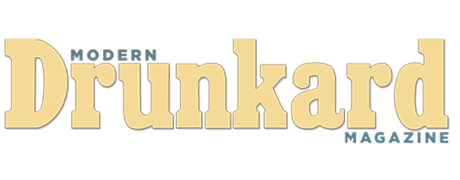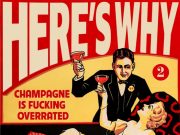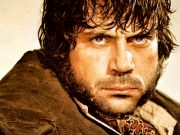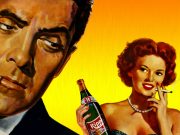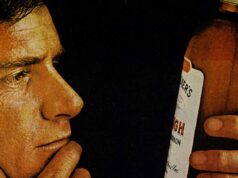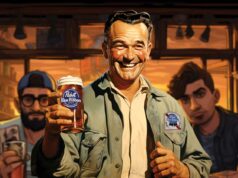4,000,000 BC Proto-simians develop large brains (suitable for bar tab calculations), stereoscopic vision (a prerequisite for double-vision), and opposable thumbs (to hold a drinking vessel). Our ancestors now have the capacity, if not the keg, to party down.
150,000 BC Australopithecus Man realizes that sucking on rotted fruit adds joy to the two most popular Xtreme sports of the day: 1) Spearing wooly mammoths, and 2) Running from wounded and angry woolly mammoths. The possibility of food poisoning and the horrid flavor merely adds to the excitement, prompting grunting contests of: “Taste grates!” and “Less killing!”
12,000 BC Sumerians learn how to brew beer. While it was once universally accepted that nomadic tribes first settled down to cultivate grains for bread, some historians now believe they built villages to make brew.
4,000 BC A formula for beer, the world’s oldest known recipe, is inscribed onto a clay tablet. Part of an epic poem devoted to Ninkasi, the Sumerian goddess of beer, it harkens back to a time when Iraqis drank beer and were cool.
3000 BC The Gilgamesh Epic, perhaps the oldest written story on earth, is put to stone. In this Sumerian tale Enkidu, a shaggy, unkempt, and thoroughly uncouth man decides to jump Gilgamesh, a local demigod. Taking no chances, Gilgamesh dispatches a whore to Enkidu to learn of his strengths and weaknesses. Instead, the harlot gives him six beers and “in this condition he washed himself and became a human being.” Proving all you need is a sixer and a prostitute to civilize the most savage of men.
2800 BC A brilliant isolated tribe living off the coast of Scotland begin brewing a hallucinogenic ale out of, among other things, hemlock, nightshade and cow dung. Undoubtedly prompting the first unironic usage of the phrase: “Hey, this beer tastes like shit.”
2600 BC The Sumerian empire collapses and the Babylonians take over the beer brewing process, developing over 20 different types of beer.
2400 BC Beer is rationed to the slaves building the Egyptian pyramids. Conversations around the beer cooler range from, “That head whip man Cherops is a real asshole,” to “I heard we’re building this fucker because some fancy pants wants to make a big splash in the afterlife. Believe that shit?”
1810 BC In Mesopotamia, King Simrilim’s alchemists discover the secrets of distillation. Afraid to drink what they think might be a powerful poison, they use it as a base for perfumes, totally missing the boat.
1800 BC The fad of chewing rice, chestnuts and millet then spitting the mush into a tub to ferment sweeps China. Confucius later quips: “Man with big mouth should make delicious beer, not bodacious boasts.”
1790 BC The Laws of Hammurabi codifies the making, selling, and purchasing of wine in Babylon. Instead of merely getting stiffed, bartenders who screw up are punished with loss of limbs and drowning.
1500 BC Greeks develop the first drinking games, including: Make the Phallic-Shaped Wine Vessel Disappear, Hide and Go Sleep It Off, Don’t Bogart the Wine Skin, and Dionysus Made Me Sleep With Your Five Wives.
1100 BC A forerunner of Modern Drunkard Magazine appears. In the Finnish poetic saga Kalewala, 200 verses are used to describe the creation of the earth, while 400 are devoted to beer.
1050 BC The Romans learn the secret of wine making from the Phoenicians. They expand on the basic recipe, developing varieties that include seawater, vinegar, resin and turpentine, a tradition carried on today by the Thunderbird and Night Train wineries.
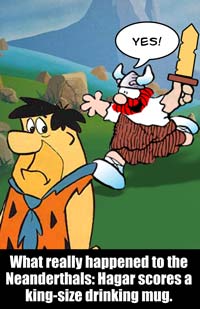 1000 BC Vikings start the fad of using the skulls of their enemies as drinking vessels, prompting the cautionary phrase, “You better watch it, fat head, or I’ll tell the Vikings where you live.”
1000 BC Vikings start the fad of using the skulls of their enemies as drinking vessels, prompting the cautionary phrase, “You better watch it, fat head, or I’ll tell the Vikings where you live.”
900 BC The ritual of binge drinking (in layman’s terms “partying hard”) becomes popular among Teutons in northern Europe because poor preservation techniques and seasonal availability of ingredients dictate periods of feast and famine.
800 BC The first wine snob rears his ugly nose. Roman scribe Tacitus writes: “To drink, the Teutons have a horrible brew fermented from barley or wheat, a brew which is very far removed our excellent wines.”
323 BC Alexander the Great drinks himself to death during his “33rd Birthday/I Just Kicked the Entire Known World’s Ass” blow out.
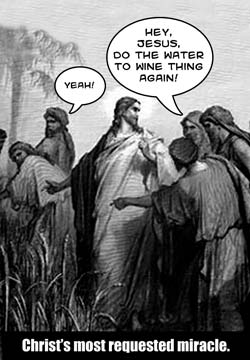 30 Performing his first miracle, Jesus turns water into wine at a wedding, rescuing the occasion from becoming a dull affair. Christ’s entourage soon doubles.
30 Performing his first miracle, Jesus turns water into wine at a wedding, rescuing the occasion from becoming a dull affair. Christ’s entourage soon doubles.
100 Early Christians introduce wine into their religious ceremonies. The Catholic Church would later ritualize the ceremony as Mass, and “the religion that kicks down free wine” spreads like wildfire to every corner of the globe.
300 Aztecs ferment cactus into pulque, doubling the attendance of Hurl The Human Head Through The Hoop matches. They also develop the “rabbit scale” to describe degrees of intoxication, ranging from very mild intoxication (a couple rabbits) to heavy drunkenness (400 rabbits). The phrase, “I’m gonna get as pulqued up as 400 rabbits fucking” becomes commonplace.
476 German barbarians on a heavily-armed road trip to check out Roman wines sack Rome, inadvertently bringing on the Dark Ages. Later the barbarians would apologize, explaining they “only wanted to party.”
500 Monasteries take over the brewing of beer, prodded by the fact that beer was not considered food, so was permitted during periods of fasting. In many monasteries, each monk was allowed to drink 5 liters of beer per day. Monk scrolls from the period are littered with affirmations of: “Dude, God is so cool.”
600 An early form of whiskey is invented in Ireland by monks who had traveled to the Near East to learn the secrets of perfume distillation. Reckoning it’s a far better thing to feel great than smell good, they apply the formula to fermented barley and coin the phrase, “Let’s get stinkin’ drunk.”
625 Mohammed declares alcohol is evil. Europeans wonder, “Well, what shall the Muslims do for fun?”
711 Muslims invade Europe.
732 Ferocious winehead Charles Martel defeats the Moors at the Battle of Tours, rescuing Europe from the horrors of sobriety.
1000 The first beer-witches are burned at the stake. When batches went bad, the brewers, fearful of thirsty and vengeful villagers, blamed black magic and rounded up the nearest old lady with more than five cats. Much as the bartenders of today blame lousy pours of Guinness on the evil magic of “goddamn distributors who won’t clean the fucking lines.”
1150 The Slavs invent vodka. The Russians cleverly call it “little water,” as in: “I ain’t drinking, I’m just having a little water.”
1171 English soldiers under King Henry II invade Ireland and discover the locals are making whiskey. They still haven’t left.
1241 Ogendai Khan, Genghis’ successor, drinks himself to death on the eve of battle. Bummed out by their Party Meister’s death, the Mongol Hordes are defeated outside Vienna and start a long hungover march back to Mongolia.
1250 Franciscan philosopher and theologian Raimundus Lullus declares alcohol is ultima consolatio corporus humani (the greatest comfort for the human body.) Boozeheads of the day respond with anche, li ottiene bevuti (also, it gets you loaded.)
1494 Proper scotch whiskey makes its first appearance when Friar John Corr gets his hands on enough malt to produce more than 1000 bottles of strong hooch. It was marketed in Scotland as good medicine, providing relief from a wide variety of ailments, including being cold, sober, thirsty or under attack by the English.
1500 Not thinking much of the local cactus brew, Spanish conquistadors in Mexico begin distilling the Aztec’s pulque and come up with a mezcal wine. They are now only a short step away from tequila and long arrest records.
1516 Germans institute the Reinheitsgebot, a law dictating that beer can be made from only four ingredients: barley, hops, yeast, and water. The Budweiser family prepares to flee the country.
1530 Theophrastus Philippus Aureolus Bombastus von Hohenheim coins the word alcohol, which he cribbed from the Arabic word al-kuhl, meaning “delicate powder.” It quickly replaces the earlier, wussyish expression spiritus vini.
1620 The Puritans land the Mayflower at Plymouth Rock because they’re running low on supplies, “especially our beere.” This was despite the fact they loaded on more brew than water before they sailed for the New World.
1621 The Puritans and local natives sit down for the first Thanksgiving Dinner. While there isn’t any cranberry sauce, mashed potatoes, sweet potatoes or pumpkin pie to be had, there is plenty of brandy, gin, and wine on hand. The natives suggest they should not only do this once a year, but maybe every week.
1600 The manufacture of rum becomes colonial New England’s largest and most prosperous industry. Ironically, the pirates who preyed upon the rum ships are now the namesakes of many present-day brands of the liquor.
1650 Dutchman Dr. Franciscus Sylvius invents gin by infusing grain alcohol with juniper berries. The doctor insists it is strictly for “medicinal purposes” and prescribes it for cold feet, insomnia, and headaches caused by drinking too much medicine the night before.
1689 Dutchman William of Orange takes the throne of England, fancies up his name to King William III, then turns on the entire nation to gin. In a single generation gin will almost magically transform Englishmen from barbaric ale-swilling savages into savage gin-swilling barbarians.
1690 Blind Benedictine Monk Dom Perignon screws up a batch of wine and accidentally invents champagne. Upon tasting the disaster, he tries to put a nice face on it by declaring, “Come quickly, brothers, I’m drinking stars! This is exactly what I was trying to do! Man, don’t you get it? Soulless celebrities will pay major francs for this crap!” The following morning Dom declares, “I feel head fire!”
1740 Grog becomes a staple of the British Navy. The tradition of watering down rum continues today. In certain bars.
1750 The mint julep is invented in either Kentucky or Maryland. This refreshing pick-me-up quickly becomes the morning coffee of the upper class, who don’t have to be sober for work.
1763 The first possible invention of the martini. Depending on which outrageous lie you wish to believe, it was invented by either a Parisian nobleman (a lying Frenchman), a New Orleans distiller (a descendant of lying Frenchmen), a Colonial-Era barmaid (every known one to tell the truth?), a bartender in California (see previous), a Midwestern housewife (ha!) and about a dozen others.
1775 General George Washington issues orders that Colonial soldiers are to receive a daily ration of four ounces of either rum or whiskey. The American troops win their first major battle two weeks later.
 1776 Thomas Jefferson pens the first draft of the Declaration of Independence in a Philadelphia tavern. The final draft, written while sober, would omit the provisions demanding “Faster service from the goddamn lazy barmaids” and “I think it self-evident that if some guys leave one party and go somewhere else and throw their own party, the guys from the first party don’t have the right to come over and drink all the other guys’ beer.”
1776 Thomas Jefferson pens the first draft of the Declaration of Independence in a Philadelphia tavern. The final draft, written while sober, would omit the provisions demanding “Faster service from the goddamn lazy barmaids” and “I think it self-evident that if some guys leave one party and go somewhere else and throw their own party, the guys from the first party don’t have the right to come over and drink all the other guys’ beer.”
1787 Following the drafting of the U.S. Constitution, the 55 signers throw a shindig, consuming 54 bottles of Madeira, 60 bottles of claret, 8 bottles of whiskey, 22 bottles of port, 8 bottles of hard cider, 12 beers and seven bowls of alcohol punch large enough that “ducks could swim in them.” This is also the first recorded instance of Ben Franklin doing his “hold this kite string for a second” prank.
1789 Undoubtedly inspired by the Almighty, Elijah Craig, a Baptist minister, invents bourbon in Georgetown, Kentucky.
1792 Dr. Pierre Ordinaire invents absinthe in Switzerland. Rather familiarly, the doctor declares it a healthful medicine, and any drunken madness that might result is purely coincidental.
1801 Thomas Jefferson runs up a wine bill of $10,835 ($103,000 in modern dollars) while president. He informs the nation, “I’ll get you back next week.”
1806 The term cocktail is used in print the first time in the American magazine The Balance. It supplants the term bittered sling, and the previously disdained Sixty Horrifying Minutes of Bittered Slings is replaced by the much more popular Cocktail Hour.
1810 The future King Ludwig I’s wedding party is so kick-ass it becomes an annual event known as Oktoberfest.
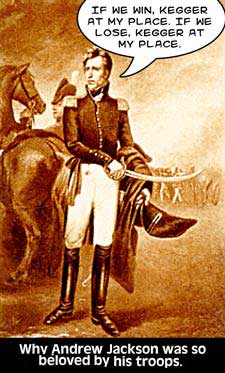 1814 A ragtag collection of drunkards, led by a super-drunkard (future President Andrew Jackson), defeats a numerically superior and disgracefully sober force of British soldiers in the Battle of New Orleans. The city is now safe for 24-hour boozing and breast-flashing sorority girls.
1814 A ragtag collection of drunkards, led by a super-drunkard (future President Andrew Jackson), defeats a numerically superior and disgracefully sober force of British soldiers in the Battle of New Orleans. The city is now safe for 24-hour boozing and breast-flashing sorority girls.
1815 On the eve of the Battle of Waterloo, Napoleon Bonaparte declares, “I drink champagne when I win, to celebrate … and I drink champagne when I lose to console myself. So no matter what goes down tomorrow, I’m getting loaded.”
1825 The gin and tonic is invented in India by British soldiers. The quinine-laced tonic water was proscribed as a malaria preventive, and the ingenious troops found adding gin made the nasty stuff slide right down. A chunk of lime was later added to fight scurvy during sea voyages. Churchill would later declare, “The gin and tonic has saved more Englishmen’s lives, and minds, than all the doctors in the Empire.”
1850 The corkscrew is invented. Drunks no longer have to push the cork down into the bottle with a pen. For the first time, beer is sold in bottles.
1862 A perpetually loaded General Ulysses S. Grant saves the Union from destruction. President Lincoln, when informed that General Grant preferred to guzzle whiskey while leading the troops, replies, “Find out the name of the brand so I can give it to my other generals.”
1863 A precocious 13-year-old lad named Jack Daniels buys a distillery in Lynchburg, Tennessee and begins producing his own brand of whiskey. By the time he bought the distillery, young Jack had already six years experience distilling liquor.
1873 The number of legal breweries in America peaks at 4,131.
1874 Lady Randolph Churchill, Winston Churchill’s mother, invents the Manhattan.
1890 The highball is invented in a St. Louis saloon.
1898 The Daiquiri is conceived by American engineer Jennings Cox in Cuba, ostensively to combat outbreaks of malaria. Bars in Havana run ads stating: “Which sounds cooler: Drunk on Daquiris or Death by Disease? Eh, Gringo?”
1899 The first political cocktail, the Cuba Libre (Free Cuba) is invented near the end of the Spanish American War when an American officer mixes rum with an otherwise useless beverage called Coca-Cola.
 1901 Absinthe devotee Pablo Picasso begins his Blue Period, followed shortly by his Hammered Beyond All Belief Period.
1901 Absinthe devotee Pablo Picasso begins his Blue Period, followed shortly by his Hammered Beyond All Belief Period.
1910 Absinthe is banned in the nation of its birth, Switzerland. Dozens of countries follow suit and France, the last holdout, declares the manufacture and consumption of absinthe illegal in 1915.
1915 The Singapore Sling is invented by barman Ngiam Tong Boon at Raffle’s Hotel in Singapore.
1920 Prohibition goes into effect in the United States.
1922 The Lost Generation begins forming up in Paris. Americas finest young writers, fleeing prohibition in their native land, use the backdrop of post-war Europe and untold amounts of booze to create some of the 20th Century’s finest literature.
1923 Illegal speakeasies usher in the Lounge Era. These underground clubs boast swank interiors, overpriced booze, and, yes, women. Prohibition, which was largely instigated by women, is now serving to introduce women to bars and the men who like to drink in them.
1929 Since the start of Prohibition, 700,000,000 gallons of beer, wine and liquor have been illicitly produced (and drank) in the US. In Paris, a devastating blow is delivered to hangovers as Pete Petoit develops the first prototype of the Bloody Mary in Harry’s Bar.
1930 Don “the Beachcomber Beach” creates the Zombie as a hangover cure.
 1933 FDR signs the bill that dissolves Prohibition, and celebrates with the first (legal) martini in 13 years. Sadly, many American breweries would not survive the drought and America is now stuck with a handful of ever-growing macrobreweries. With $5,000 and a recipe found in a pamphlet borrowed from a public Library, brothers Ernest and Julio Gallo began building a wine-making empire. In the next eighty years they will produce millions of gallons of “budget” wine and inflict nearly as many psyche-shattering hangovers.
1933 FDR signs the bill that dissolves Prohibition, and celebrates with the first (legal) martini in 13 years. Sadly, many American breweries would not survive the drought and America is now stuck with a handful of ever-growing macrobreweries. With $5,000 and a recipe found in a pamphlet borrowed from a public Library, brothers Ernest and Julio Gallo began building a wine-making empire. In the next eighty years they will produce millions of gallons of “budget” wine and inflict nearly as many psyche-shattering hangovers.
1935 Jagermeister is invented in Wolfenbuttel, Germany. On the other side of the Atlantic, canned beer is introduced by the Kreuger Brewing Company in Richmond, VA.
1938 Writer H. L. Mencken announces that 17,864,392,788 different cocktails can be made from the ingredients in a well-stocked bar. The Bartender’s Guild considers having him assassinated.
1939 France fearfully watches Germany rearm under the guidance of a teetotaler with a Charlie Chaplin mustache. France wonders, “What shall he do for fun?”
1940 Germany invades France.
1944 Trader Vic invents the Mai Tai in Oakland, CA.
1945 The Allies, led by full-bore boozers Churchill, FDR and Stalin, defeat the Axis Powers, led by a sinister cabal of teetotalers and lightweights. The world is now safe for drinkers. And democracy.
1948 Happy Hour is invented in Chicago.
1947 Humphrey Bogart forms the first incarnation of the Rat Pack in Hollywood. Later headed by Frank Sinatra, the Pack would dictate what was hip until the hippies came along and screwed everything up. In St. Louis, the Hyde Park brewery airs the first beer commercial on television.
1950 Flying in the face of the Red Scare, vodka begins to dominate the world market. The Screwdriver soon becomes the most popular drink in America.
1951 Trader Vic opens restaurants in San Francisco, Oakland, and Beverly Hills, and cocktail lounges in Seattle and Chicago. Soldiers returning from the Pacific flock to the Polynesian themed bars, ushering in the Tiki Era.
1953 The Pina Colada is first assembled in the Hotel Caribe Hilton in Puerto Rico by Ramón Marrero. The coconut cocktail would go on to win a global competition and inspire Rupert Holmes to pen a song so insidiously catchy it would haunt an entire generation.
1958 Ernest Hemingway issues a challenge to the rest of America by consuming 16 of his signature Papa Dobles cocktails in a single sitting (more than 60oz of strong rum), then walking home. Accepting the challenge, America enters a golden age of guzzling, led by celebrity avatars like Jackie Gleason, Dean Martin, Robert Mitchum and Richard Burton.
1960 The Rat Pack begins holding court at the Sands Hotel in Vegas. The Swinger Era begins.
1962 John F. Kennedy and Ernest Hemingway’s public thirst for daiquiris ignites a pop culture phenomenon.
1963 The pop top beer can is introduced by the Iron City Beer Brewing Company in Pittsburgh.
1964 Sean Connery, as James Bond, not only asks for vodka in his martini, but also insists it be shaken, not stirred, releasing a two-headed gorgon of controversy. Soon every Playboy subscriber in the civilized world is donning a tuxedo jacket and swilling vodka martinis.
1970 Wineries rapidly spread throughout California and wine spritzers and disco music suspiciously arrive at the exact same time.
1972 The Long Island Ice Tea is invented by a Long Island Bartender Robert C. “Rosebud” Butt. In defiance of all previously known laws of mixology, tequila, rum, vodka, and gin are made to play nice together.
1975 Androgynous cocktails such as the Tequila Sunrise and the Harvey Wallbanger, along with a plethora of self-help books encouraging sensitivity and outright crying, lay heavy siege to the collective masculinity of the modern male.
1978 President Jimmy Carter, in an attempt to atone for his many failures, legalizes home brewing.
1980 The first boxed wines appear in Australia and the trend soon spreads to the U.S. Drunks now have the power to tumble down a flight of stairs with two liters of wine in their hands without the worry of picking shards of glass out of their skulls while bawling over spilled wine. Jokes about American beer become popular throughout the world because as the U.S.’s 44 brewing companies produce virtually the same product: a light, tasteless, over-carbonated lager.
1981 As state laws are relaxed, microbreweries start popping up across the nation. America’s reputation as a decent beer-producing nation is redeemed. The population of beer snobs also multiples.
1985 Bartles & James takes a chance on a bizarre campaign featuring two old coots sitting on a porch asking you to buy their light and fruity wines. A wine cooler craze soon sweeps the nation, instantly doubling the chances of pimply high-school kids getting laid after the prom.
1987 Fueled by rumors that it contains morphine extracts, Jagermeister explodes out of New Orleans and sweeps the nation. It effectively secures the middle ground between manly shots (tequila and whiskey) and wussy shots (Kamikazes and fruit schnapps). The finest drinking movie ever made, the Bukowski-scripted Barfly, is released.
1990 The martini and the lounge make triumphant comebacks. On their back arrives the pseudo-martini craze, whereas even a dead rat served in a stemmed glass can be called a martini. This is also the era of the ribaldly-named cocktail, including the Sex on the Beach, Screaming Orgasm and Sloe Comfortable Screw.
1992 Flavored vodkas begin fighting for space on the bar shelves.
1996 Modern Drunkard Magazine is launched.
2003 Nearly 2000 breweries are now in operation in the United States, surpassing the number in existence prior to Prohibition.
—Frank Kelly Rich

